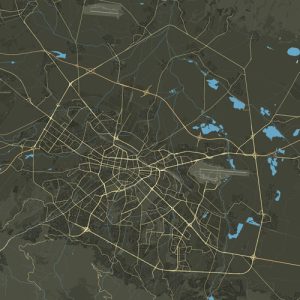In the period of the Second Bulgarian Kingdom (XII-XIV century), today’s Basarbovsky rock monastery was part of a large monastic Hesychast complex, covering the canyon of the Rusenski Lom river and its tributaries Beli and Cherni Lom. The Hesychast monks (from Hesychia – silence, silence) carved their churches and cells into the limestone rocks. Far from worldly vanity, they lived simply and ascetically. The only purpose with which they lived in constant prayer, deprivation and silence was to see Christ in His true light – the one in which He appeared on Mount Tabor.
St. Patriarch Joakim I (his memory is celebrated on January 18), who came from Mount Athos to Ruse Polomie, lived in the rock monasteries near the villages of Krasen, Ivanovo and Basarbovo. In 1235, during the reign of King John Assen II, he was elected as the first Patriarch of Turnov and canonically confirmed by the council in Lampsak in the same year.
According to historical research, the Basarbov Monastery was dedicated to St.St. Theodore Tyrone and Theodore Stratilatus. The founder of the monastery was Queen Theodora – the first wife of King John Alexander and daughter of the Wallachian Duke Ivanko Basarab (founder of the first ruling dynasty of Wallachia). That is where the name of the monastery comes from. Ivanko Basarab, as the royal father-in-law, owned this land.
After the Ottoman invasion, the rock cells and churches were deserted at various times. An Ottoman tax register from 1479-1480 mentions “Basarba Monastery”. Further information about the holy monastery comes from the life of St. Sophronius Bulgarian (more precisely, Basarbovski, celebrated on May 28), who lived in the 16th century as a monk in the Basarbov monastery. Remembered by a violent death in the monastery.
After his burial, miracles began to happen at his grave. In the third year they opened his tomb and found his body incorruptible and fragrant. His relics are located in Serbia. In the 17th century, the only known saint from the Ruse region, native of the village of Basarbovo – St. Dimitriy Basarbovski (celebrated on October 27) lived in the Basarbovo monastery. Reverend Paisiy Hilendarski testifies to this (we celebrate his memory on June 19) in his “Slavyano-Bolgarskaya History”.
St. Dimitriy was a shepherd of the village of Basarbovo, he became a monk in the Basarbovo monastery. During his earthly life he glorified God, and God glorified him in the eternal. St. Paisius mentions the year of his ascension – 1685. His relics were discovered in a miraculous way in the Rusenski Lom river, opposite the monastery. Many miracles and healings took place on the relics of the saint. On July 10, 1774, one of the many Russo-Turkish wars ended and a peace treaty was signed in the village of Kyuchuk Kaynardzha.
Russia was the winner. A clause in the treaty gave Russia the right to patronize Orthodox Christians on the territory of the Ottoman Empire. General Ivan Petrovich Saltykov († 1805, son of Field Marshal Pyotr Semenovich Saltykov † 1772), was supposed to bring the relics of St. Dimitri Basarbovsky to Russia. Their road passed through Bucharest. They arrived there on July 13, 1774. There was a plague epidemic in the city. After the relics entered Bucharest, no one died of the plague again.
The inhabitants of the city, among whom there were many Bulgarian emigrants, begged the general to leave the relics in Bucharest. The Bulgarian translator Dimitar Ment Poklonnik played an important role in this. This happened during the reign of the Hungarian-Wallachian Metropolitan Gregory II (1760-1777). To this day, holy relics are located in the cathedral “St. St. Constantine and Elena”, now Patriarchal. After St. Dimitri, it is not known that there were any monks in the monastery.
In 1912, the Basarbov monastery was the subject of an archaeological survey by the researcher of Bulgarian antiquities, Karel Shkorpil. On May 1 (May 14, 1937), the day of St. Jeremiah, during the consecration of Metropolitan Michael of Dorostol and Cherven (†1961), the Basarbov rock monastery was restored. The first resident of the monastery was monk h. Chrysant (†1961), came from the Transfiguration Monastery near Tarnovo. From its restoration until recently, there was only one monk in the holy monastery, with monk Parthenius, Archimandrite Sevastian, and hieromonk Hilarion residing successively. Archimandrite Viktor was abbot in the period 1999 – 2003. Since 2003, Archimandrite Emilian has been the abbot of the monastery.
On September 24, 2005, His Eminence Metropolitan Neophyte of Rousse laid the foundation stone of the monastery church “St. Transfiguration of the Lord”. On October 27, 2005, on the occasion of the 320th anniversary of Reverend Dimitrii’s ascension, with the blessing of the blessed patriarch Theoctistus († 2007), the monastery received the most precious gift from the Romanian Patriarchate – a living icon with an embedded particle of the relics of St. Dimitri Basarbovsky.
It is a real miracle that after the arrival of the holy relics, the monastery experienced a real flourishing and was fundamentally transformed. The foundation stone of the monastic dormitory was laid on May 31, 2007. Construction work began on July 27, 2007, the day of St. Panteleimon and St.St. Septuagints Cyril, Methodius, Clement, Nahum, Sava, Gorazd and Angelarius. All this happened with God’s blessing and through the intercession of St. Demetrius.
Today, a small but united brotherhood is active in the holy monastery. Lord, remember the founders, founders, donors and beautifiers of the Basarbov holy monastery.
Work time:
From October to March: 8:00 a.m. to 5:00 p.m.
From April to September: 8:00 a.m. to 7:00 p.m.
Entrance fees:
Entrance fee – BGN 4.
Talks are free.
Contacts:
Phones: +359 82 800 765; GSM: +359 895 665 356; +359 894 353 009

